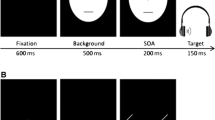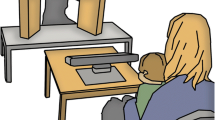Abstract
People with autism spectrum disorder (ASD) show reduced interest towards social aspects of the environment and a lesser tendency to follow other people’s gaze in the real world. However, most studies have shown that people with ASD do respond to eye-gaze cues in experimental paradigms, though it is possible that this behaviour is based on an atypical strategy. We tested this possibility in adults with ASD using a cueing task combined with eye-movement recording. Both eye gaze and arrow pointing distractors resulted in overt cueing effects, both in terms of increased saccadic reaction times, and in proportions of saccades executed to the cued direction instead of to the target, for both participant groups. Our results confirm previous reports that eye gaze cues as well as arrow cues result in automatic orienting of overt attention. Moreover, since there were no group differences between arrow and eye gaze cues, we conclude that overt attentional orienting in ASD, at least in response to centrally presented schematic directional distractors, is typical.





Similar content being viewed by others
Notes
As errors were only made on a relatively low number of trials medians rather than means were calculated so as to reduce the effect of outliers.
References
APA (1994) Diagnostic and statistical manual of mental disorders, 4th edn. American Psychiatric Association, Washington, DC
Baron-Cohen S (1994) How to build a baby that can read minds: cognitive mechanisms in mind reading. Cahiers De Psychologie Cognitive/Current Psychology of Cognition 13:513–552
Baron-Cohen S (1995) Mindblindness: an essay on autism and theory of mind. MIT Press, Cambridge
Baron-Cohen S (2000) Theory of mind and autism: a fifteen year review. In: Baron-Cohen S, Tager-Flusberg H, Cohen DJ (eds) Understanding other minds. Oxford University Press, Oxford, pp 3–20
Baron-Cohen S, Cox A, Baird G, Swettenham J, Nightingale N, Morgan K (1996) Psychological markers in the detection of autism in infancy in a large population. Br J Psychiatry 168:158–168
Baron-Cohen S, Wheelwright S, Skinner R, Martin J, Clubley E (2001) The autism-spectrum quotient (AQ): evidence from Asperger syndrome/high-functioning autism, males and females, scientists and mathematicians. J Autism Dev Disord 31(1):5–17
Bayliss AP, di Pellegrino G, Tipper SR (2005) Sex differences in eye gaze and symbolic cueing of attention. Q J Exp Psychol Sect A Hum Exp Psychol 58(4):631–650
Benson V, Piper J, Fletcher-Watson S (2009) Atypical saccadic scanning in autistic spectrum disorder. Neuropsychologia 47(4):1178–1182
Bird G, Catmur C, Silani G, Frith C, Frith U (2006) Attention does not modulate neural responses to social stimuli in autism spectrum disorders. Neuroimage 31(4):1614–1624
Bonato M, Priftis K, Marenzi R, Zorzi M (2009) Normal and impaired reflexive orienting of attention after central nonpredictive cues. J Cogn Neurosci 21(4):745–759
Brothers L (1990) The social brain: a project for integrating primate behaviour and neurophysiology in a new domain. Concepts Neurosci 1:27–51
Chawarska K, Klin A, Volkmar F (2003) Automatic attention cueing through eye movement in 2-year-old children with autism. Child Dev 74(4):1108–1122
Corkum V, Moore C (1998) The origins of joint visual attention in infants. Dev Psychol 34:28–38
Dalton KM, Nacewicz BM, Johnstone T, Schaefer HS, Gernsbacher MA, Goldsmith HH et al (2005) Gaze fixation and the neural circuitry of face processing in autism. Nat Neurosci 8(4):519–526
Dawson G, Carver L, Meltzoff AM, Pagagiotides H, McPartland J, Webb SJ (2002) Neural correlates of face and object recognition in young children with autism spectrum disorder, developmental delay and typical development. Child Dev 73:700–717
Deaner RO, Platt ML (2003) Reflexive social attention in monkeys and humans. Curr Biol 13(18):1609–1613
Downing PE, Dodds CM, Bray D (2004) Why does the gaze of others direct visual attention. Vis Cogn 11(1):71
Driver J, Davies M, Ricciardelli P (1999) Gaze perception triggers reflective visiospatial orienting. Vis Cogn 6(5):509–540
Emery NJ (2000) The eyes have it: the neuroethology, function and evolution of social gaze. Neurosci Biobehav Rev 24(6):581–604
Fletcher-Watson S, Leekam SR, Benson V, Frank MC, Findlay JM (2009) Eye-movements reveal attention to social information in autism spectrum disorder. Neuropsychologia 47(1):248–257
Friesen CK, Kingstone A (1998) The eyes have it! Reflexive orienting is triggered by nonpredictive gaze. Psychon Bull Rev 5(3):490–495
Friesen CK, Ristic J, Kingstone A (2004) Attentional effects of counterpredictive gaze and arrow cues. J Exp Psychol Hum Percept Perform 30(2):319–329
Frischen A, Bayliss AP, Tipper SP (2007a) Gaze cueing of attention: visual attention, social cognition, and individual differences. Psychol Bull 133(4):694–724
Frischen A, Smilek D, Eastwood JD, Tipper SP (2007b) Inhibition of return in response to gaze cues: the roles of time course and fixation cue. Vis Cogn 15(8):881–895
Grelotti DJ, Gauthier I, Schultz R (2002) Social interest and the development of cortical face specialisation: what autism teaches us about face processing. Dev Psychobiol 40(3):213–225
Hietanen JK, Leppanen JM (2003) Does facial expression affect attention orienting by gaze direction cues? J Exp Psychol Hum Percept Perform 29(6):1228–1243
Hietanen JK, Nummenmaa L, Nyman MJ, Parkkola R, Hamalainen H (2006) Automatic attention orienting by social and symbolic cues activates different neural networks: an fMRI study. Neuroimage 33(1):406–413
Hill RL (2004) Evaluating the theory of executive dysfunction in autism. Dev Rev 24:189–233
Hommel B, Pratt J, Colzato L, Godijn R (2001) Symbolic control of visual attention. Psychol Sci 12(5):360–365
Hood BM, Willen JD, Driver J (1998) Adult’s eyes trigger shifts of visual attention in human infants. Psychol Sci 9(2):131–134
Humphreys K, Hasson U, Avidan G, Minshew N, Behrmann M (2008) Cortical patterns of category: selective activation for faces, places and objects in adults with autism. Autism Res 1(1):52–63
Jemel B, Mottron L, Dawson M (2006) Impaired face processing in autism: fact or artefact? J Autism Dev Disord 36:91–106
Kingstone A (2009) Taking a real look at social attention. Curr Opin Neurobiol 19(1):52–56
Kingstone A, Smilek D, Eastwood JD (2008) Cognitive ethology: a new approach for studying human cognition. Br J Psychol 99:317–340
Klin A, Jones W, Schultz R, Volkmar F, Cohen D (2002) Visual fixation patterns during viewing of naturalistic social situations as predictors of social competence in individuals with autism. Arch Gen Psychiatry 59(9):809–816
Klin A, Jones W, Schultz R, Volkmar F (2003) The enactive mind, or from actions to cognition: lessons from autism. Philos Trans R Soc London 358(1430):345–360
Kuhn G, Benson V (2007) The influence of eye-gaze and arrow pointing distractor cues on voluntary eye movements. Percept Psychophys 69(6):966–971
Kuhn G, Kingstone A (2009) Look away! Eyes and arrows engage oculomotor responses automatically. Percept Psychophys 71(2):314–327
Kuhn G, Land MF (2006) There’s more to magic than meets the eye. Curr Biol 16(22):R950–R951
Kuhn G, Tatler BW, Cole GG (2009) You look where I look! Effect of gaze cues on overt and covert attention in misdirection. Vis Cogn 17(6):925–944
Kylliainen A, Hietanen JK (2004) Attention orienting by another’s gaze direction in children with autism. J Child Psychol Psychiatry 45(3):435–444
Landry R, Bryson SE (2004) Impaired disengagement of attention in young children with autism. J Child Psychol Psychiatry 45(6):1115–1122
Langton SRH, Watt RJ, Bruce V (2000) Do the eyes have it? Cues to the direction of social attention. Trends Cogn Sci 4(2):50–59
Leekam SR, Baron-Cohen S, Perrett D, Milderst M, Brown S (1997) Eye direction detection: a dissociation between geometric and joint attention skills in autism. Br J Dev Psychol 15:77–95
Leekam SR, Hunnisett E, Moore C (1998) Targets and cues: gaze following in children with autism. J Child Psychol Psychiatry 39:951–962
Leekam SR, Lopez B, Moore C (2000) Attention and joint attention in preschool children with autism. Dev Psychol 36(2):261–273
Mansfield EM, Farroni T, Johnson MH (2003) Does gaze perception facilitate overt orienting? Vis Cogn 10(1):7–14
Mundy P (1995) Joint attention and social-emotional response in children with autism. Dev Psychopathol 7:247–252
Mundy P, Burnette C (eds) (2005) Joint attention, social competence and developmental models of autism, 3rd edn. Wiley, Hoboken
Nation K, Penny S (2008) Sensitivity to eye gaze in autism: is it normal? Is it automatic? Is it social? Dev Psychopathol 20(1):79–97
Ozonoff S, Pennington BF, Rogers SL (1991) Executive function deficits in high-functioning autistic individuals: relationship to theory of mind. J Child Psychol Psychiatry 32:1081–1105
Posner MI (1980) Orienting of attention. Q J Exp Psychol 32:3–25
Posner MI, Cohen NJ (1984) Components of visual orienting. In: Bouma H, Bowhuis DG (eds) Attention and performance X: control of language processes. Erlbaum, Hillsdale, pp 531–556
Riby DM, Hancock PJ (2008) Viewing it differently: social scene perception in Williams syndrome and Autism. Neuropsychologia 46(11):2855–2860
Riby DM, Doherty-Sneddon G, Bruce V (2008) Atypical unfamiliar face processing in Williams syndrome: what can it tell us about typical familiarity effects? Cogn Neuropsychiatry 13(1):47–58
Ricciardelli P, Bricolo E, Aglioti SM, Chelazzi L (2002) My eyes want to look where your eyes are looking: exploring the tendency to imitate another individual’s gaze. Neuroreport 13(17):2259–2264
Ristic J, Kingstone A (2006) Attention to arrows: pointing to a new direction. Q J Exp Psychol 59(11):1921–1930
Ristic J, Friesen CK, Kingstone A (2002) Are eyes special? It depends on how you look at it. Psychon Bull Rev 9(3):507–513
Ristic J, Mottron L, Friesen CK, Iarocci G, Burack JA, Kingstone A (2005) Eyes are special but not for everyone: the case of autism. Cogn Brain Res 24(3):715–718
Rutherford MD, Krysko KM (2008) Eye direction, not movement direction, predicts attention shifts in those with autism spectrum disorders. J Autism Dev Disord 38(10):1958–1965
Sasson N (2006) The development of face processing in autism. J Autism Dev Disord 36(3):381–394
Schultz RT (2005) Developmental deficits in social perception in autism: the role of the amygdala and fusiform face area. Int J Dev Neurosci 23(2–3):125–141
Senju A, Johnson MH (2009) The eye contact effect: mechanisms and development. Trends Cogn Sci 13(3):127–134
Senju A, Tojo Y, Dairoku H, Hasegawa T (2004) Reflexive orienting in response to eye gaze and an arrow in children with and without autism. J Child Psychol Psychiatry 45(3):445–458
Swettenham J, Condie S, Campbell R, Milne E, Coleman M (2003) Does the perception of moving eyes trigger reflexive visual orienting in autism? Philos Trans R Soc London 358(1430):325–334
Tantam D (1992) Characterizing the fundamental social handicap in autism. Acta Paedopsychiatr 55(2):83–91
Tatler BW, Kuhn G (2007) Don’t look now: the magic of misdirection. In: van Gompel RPG, Fischer MH, Murray WS, Hill RL (eds) Eye movements: a window on mind and brain. Elsevier, Oxford, pp 697–714
Theeuwes J, Kramer AF, Hahn S, Irwin DE, Zelinsky GJ (1999) Influence of attentional capture on oculomotor control. J Exp Psychol Hum Percept Perform 25(6):1595–1608
Tipper CM, Handy TC, Giesbrecht B, Kingstone AF (2008) Brain responses to biological relevance. J Cogn Neurosci 20(5):879–891
Tipples J (2002) Eye gaze is not unique: automatic orienting in response to uninformative arrows. Psychon Bull Rev 9(2):314–318
Tipples J (2008) Orienting to counterpredictive gaze and arrow cues. Percept Psychophys 70(1):77–87
Townsend JT, Ashby FG (1983) The stochastic modeling of elementary psychological processes. Cambridge University Press, Cambridge
Webster S, Potter DD (2008) Brief report: eye direction detection improves with development in autism. J Autism Dev Disord 38(6):1184–1186
Wechsler D (1999) Wechsler Abbreviated Scale of Intelligence (WASI). Harcourt Assessment, San Antonio
Acknowledgments
The first author was funded by the Wolfson Research Institute, Durham University, UK. G. Kuhn and V. Benson conceived the experiment. G. Kuhn, V. Benson, S. Fletcher-Watson and S.R. Leekam wrote the paper. G. Kuhn designed the experiment and analyzed the data. H. Kovshoff, C. A. McCormick and J. Kirkby recruited the participants and ran the experiment.
Author information
Authors and Affiliations
Corresponding author
Rights and permissions
About this article
Cite this article
Kuhn, G., Benson, V., Fletcher-Watson, S. et al. Eye movements affirm: automatic overt gaze and arrow cueing for typical adults and adults with autism spectrum disorder. Exp Brain Res 201, 155–165 (2010). https://doi.org/10.1007/s00221-009-2019-7
Received:
Accepted:
Published:
Issue Date:
DOI: https://doi.org/10.1007/s00221-009-2019-7




